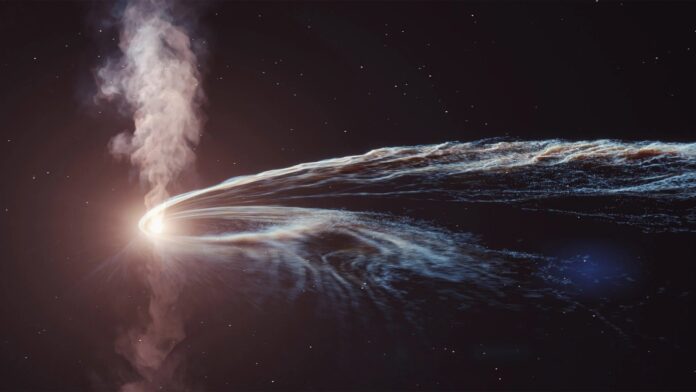A tiny star was torn to pieces in October 2018 after it strayed too close to a black hole in a galaxy 665 million light years from Earth. Although it may sound exciting, astronomers who occasionally see these violent episodes while watching the night sky were not surprised by the event.
But, astronomers were surprised after finding that the same black hole is lighting up the skies again and has not swallowed anything new. The team spotted the unusual outburst while revisiting tidal disruption events (TDEs) that occurred over the last several years.
The observations led the team to conclude that the black hole was now ejecting material traveling at half the light speed. This is the first time they see a black hole spewing stellar remains years after consuming a star. It is more like the black hole is burping after a meal.
The black hole was suddenly reanimated in June 2021, according to radio data collected by the Very Large Array (VLA) in New Mexico. Yvette Cendes, a research associate at the Center for Astrophysics | Harvard & Smithsonian (CfA), and the team rushed to examine the event more closely.
Cendes explained, “We applied for Director’s Discretionary Time on multiple telescopes. When you find something so unexpected, you can’t wait for the normal cycle of telescope proposals to observe it. All the applications were immediately accepted.”
Edo Berger, professor of astronomy at Harvard University and the CFA and co-author on the new study, said, “We have been studying TDEs with radio telescopes for more than a decade, and we sometimes find they shine in radio waves as they spew out material while the black hole is first consuming the star. But in AT2018hyz, there was radio silence for the first three years, and now it’s dramatically lit up to become one of the most radio-luminous TDEs ever observed.”
Sebastian Gomez, a postdoctoral fellow at the Space Telescope Science Institute and co-author of the new paper, says that AT2018hyz was “unremarkable” in 2018 when he first studied it using visible light telescopes, including the 1.2-m telescope at the Fred Lawrence Whipple Observatory in Arizona.”
“Using theoretical models, we calculated that the star torn apart by the black hole was only one-tenth the mass of our Sun. We monitored AT2018hyz in visible light for several months until it faded away and set it out of our minds.”
Cendes explained, “The emission, known as an outflow, normally develops quickly after a TDE occurs — not years later. In this case, it’s as if this black hole has started abruptly burping out a bunch of material from the star it ate years ago.”
“The burps are resounding.”
“The outflow of material travels as fast as 50 percent the speed of light. For comparison, most TDEs have an outflow that travels at 10 percent the speed of light.”
Berger says, “This is the first time we have witnessed such a long delay between the feeding and the outflow. The next step is to explore whether this happens more regularly, and we have simply not been looking at TDEs late enough in their evolution.”
Journal Reference:
- Y. Cendes, E. Berger, et al. A Mildly Relativistic Outflow Launched Two Years after Disruption in Tidal Disruption Event AT2018hyz. The Astrophysical Journal. DOI: 10.3847/1538-4357/ac88d0
